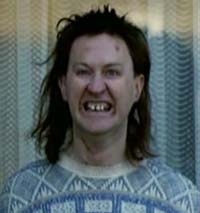
Are There Any Electricians In Tonight?
#16

Posted 19 November 2007 - 08:41 AM
#17

Posted 19 November 2007 - 10:16 AM
Does it mention a flux capacitor anywhere in the question?
#18

Posted 19 November 2007 - 10:24 AM
#20

Posted 19 November 2007 - 04:24 PM
Never ask Bungle to wire anything, ask him what happens when he wired his own house
i moved out
but my tenants are still alive and not crispy
#21

Posted 19 November 2007 - 04:37 PM
I couldn't tell you how to calculate them though
I might be insulting your intelligence but you do know the V I R and P I V triangles, right? If not, read on...
V P
I R and I V
Where V=Voltage, I=Current (in amps), P=Power (in Watts) and R=Resistance (in Ohms)...
So I believe to calculate the Voltage across a Resistor you need the Current (in amps) and the value of the Resistor, and the equation would be V=IxR (current in amps times Resistance in ohms). Remember though to take each value back to its 'normal' form i.e. if the Resistance is 1K Ohm that's 1000 Ohms so make sure you put it as 1000 in the equation.
If you're unsure and think the answer is wrong you can always reverse the equation in two other ways by using the triangles above. i.e. if you've just worked out the Voltage, then you'll have already known the Current and Resistance because you'll have needed them to calculate it. So you can use V/R which should give you the 'I' (Current) value that you already had.
It all goes back to the two triangles above. To work out one, you need the other two. For example if they ask you to work out the total Power of a circuit and they just give you the total Resistance (or even each individual resistor in which case you'd have to calculate the total resistance by using R+R+R if it's in series or a slightly more complicated equation if it's in parallel) and total Voltage, you'll need to use the first triangle to work out the Current (I) and then take that result and put it into the second triangle to work out the Power.
Hope that helps, racked my brains a little bit there!
#22

Posted 19 November 2007 - 06:48 PM
Its the time constant tau, that they are asking for, and even though i sound like i should know the answer which i should, it seems to have escaped me.....
All i have flying round my head are bleeding impedance equations, xc=1/ 2.pi.f.C etc etc
I dont tihnk iv ever needed to find a time constant in my life...... :S (albeit a short one)
edit: sory part two does ask for the voltage dropped across the circuit
and someone earlier mentioned that you shouldnt have to do the question because nothing would happen is correct lol, you oculd always be pedantic and say its an open circuit and as such nothing will happen, but i dont think your tutor will be best pleased.
edit part 2:
for calculating charge on a capacitor you could use Q=VC
where Q is in coulomb, V in Volt and C is in Henry
edit part 3:
and using this and i tihnk i understand the question correctly the capacitor is fully charged at 5xC.R.
therefore Q=5xC.R
and using t=C.R, t=VC/5
I tihnk.
Edited by Ausy, 19 November 2007 - 06:57 PM.
#23

Posted 19 November 2007 - 08:05 PM
Ok, I do electronics - but I'm dyscalculic........so I'm NO good with maths. To b honest I tend to just use component values that are close enough to match the circuit I'm building.......and then use a bigger value if they let the magic smoke out...

I *think* the question requires Kirchhoff's Voltage Law to solve the question, or Kirchhoff's Current Law. I think.
Sorry can't help out much more - it's a bit beyond my abilities.
SS
doh and i was hoping that you would know!!
My other half is a fully qualified Electrician.... but also has a degree in Electronic engineering..... if you can wait until tonight, when he gets home I'll get him to have a look and see if he can help!
yep i can wait, what time does night start?!!
#24

Posted 19 November 2007 - 08:21 PM
So if the capacitor is fully charged, there should be no voltage drop across the resistor.
Are you studying power factor correction on three phase motor circuits by any chance ?
#25

Posted 19 November 2007 - 08:39 PM
If a voltage is applied to an uncharged capacitor through a resistance, the voltage across the capacitor rises slowly until it eventually equals the source voltage. Likewise, if a resistor is connected to a charged capacitor, the voltage slowly decays to zero.
So if the capacitor is fully charged, there should be no voltage drop across the resistor.
Are you studying power factor correction on three phase motor circuits by any chance ?
no! i'm doing a btec in electrical engineering
#26

Posted 20 November 2007 - 08:19 AM
If a voltage is applied to an uncharged capacitor through a resistance, the voltage across the capacitor rises slowly until it eventually equals the source voltage. Likewise, if a resistor is connected to a charged capacitor, the voltage slowly decays to zero.
So if the capacitor is fully charged, there should be no voltage drop across the resistor.
Are you studying power factor correction on three phase motor circuits by any chance ?
no! i'm doing a btec in electrical engineering
Edit: getting good withthese edits now...
seems i was wrong earlier,
and its not as simple as what i said.
This i have just copied from a worksheet i received in HNC regarding charging of capicitors.
will upload later its proving a pain in the arse to type it out.
another little point that might be worth noting is that T (which is RC) is the time it takes for a change of 63.3%
i.e at time T Vc=0.633 Vs
that may help
(this is what i typed out, and is the maths behind the 63.3%)
Over an infinitely small change in time Vr /R = Q/t where t is time in seconds.
Hence Vr=R dQ/dt (call this equation A)
For the capacitor we know Q= CVc
And for a small change we get Q=CVc
i.e, dQ = C dVc (equation B)
substitute B into A
Vr = RC dVc/dt
Then using Vc = Vs – Vr
Vr = Vs-Vc
This equation now tells us how Vc varies with time t but in order to use it we must solve it
In order to find T we must solve the equation (Vs-Vc)=T dVc/dt
Let Vs-Vc = x
Differentiate and since Vs is a constant we find that –dVc = dx
The equation then becomes
x= -T dx/dt x
Rearranging dt/T = - dx/x
Integrating -1/T ∫dt = ∫dx/x = [lnx]
(with limits between t and 0)
The limits become clear when we substitute x=Vs-Vc
-1/T ∫dt = ∫dx/x = [lnx]
(with limits between Vc and 0)
-t/T=[ln(Vs-Vc)-ln(Vs)]
-t/T=ln (Vs-Vc) = ln ( 1- V )
Vs Vs
Take anti logs and e1/t = 1 – Vc/Vs
Edited by Ausy, 20 November 2007 - 03:37 PM.
1 user(s) are reading this topic
0 members, 1 guests, 0 anonymous users

















